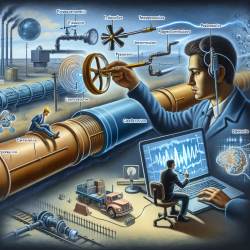Introduction
In the world of speech language pathology, we often emphasize the importance of data-driven decisions. However, the concept of using advanced algorithms to enhance precision is not limited to our field. A recent study titled "Negative Pressure Waves Based High Resolution Leakage Localization Method Using Piezoceramic Transducers and Multiple Temporal Convolutions" introduces a novel approach to pipeline leakage detection, which can inspire practitioners across various domains to improve their methodologies.
Understanding the Research
The study explores the use of piezoceramic transducers in detecting pipeline leaks with high resolution. Traditional methods often struggle with low localization resolution due to the long signal duration of negative pressure waves (NPW) generated by leaks. This new approach utilizes multiple temporal convolutions to enhance the localization resolution, significantly narrowing down the leakage area.
In an experimental setup involving a 55.8-meter pressurized pipeline, the proposed algorithm demonstrated a remarkable improvement in resolution, pinpointing leaks to within 2.5 meters—a substantial advancement over traditional methods.
Implications for Practitioners
For practitioners in speech language pathology, this research underscores the potential of leveraging advanced algorithms to improve precision in diagnosis and treatment. Here are some key takeaways:
- Precision Enhancement: Just as the proposed algorithm enhances leak detection precision, practitioners can explore data-driven tools to refine their diagnostic accuracy.
- Innovation Adoption: Embrace innovative methodologies and technologies that offer improved outcomes, whether in therapy techniques or diagnostic tools.
- Cross-Disciplinary Learning: Engage with research from other fields to inspire new approaches in your practice. The principles of high-resolution detection can be applied to various aspects of speech and language pathology.
Encouraging Further Research
This study is a testament to the power of innovation and cross-disciplinary learning. Practitioners are encouraged to delve deeper into research that explores advanced methodologies. Consider how similar principles could be applied to enhance therapy outcomes for children with speech and language disorders.
By staying informed and open to new ideas, practitioners can continuously improve their skills and contribute to better outcomes for their clients.
Conclusion
The research on high-resolution pipeline leakage detection offers valuable insights that can inspire practitioners to enhance their methodologies. By embracing data-driven decisions and innovative approaches, we can achieve greater precision and better outcomes in our respective fields.
To read the original research paper, please follow this link: Negative Pressure Waves Based High Resolution Leakage Localization Method Using Piezoceramic Transducers and Multiple Temporal Convolutions.










